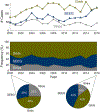Increased nationwide use of stereoencephalography for intracranial epilepsy electroencephalography recordings
- PMID: 29724650
- PMCID: PMC6188665
- DOI: 10.1016/j.jocn.2018.04.064
Increased nationwide use of stereoencephalography for intracranial epilepsy electroencephalography recordings
Abstract
Intracranial electroencephalography (iEEG) can be performed using minimally invasive stereo-electroencephalography (SEEG) or by implanting subdural electrodes via a craniotomy or multiple burr holes. There is anecdotal evidence that SEEG is becoming more common in the United States, though this has yet to be quantified. To address this question, all SEEG and burr hole/craniotomy subdural iEEG procedures were extracted from the Centers for Medicare and Medicaid Services Part B data files for the years 2000-2016. National trends were compared over time. In 2016, SEEG became the most frequently performed intracranial monitoring procedure in the Medicare population, increasing from 28.8% of total cases in 2000 to 43.1% in 2016 (p = 0.02). The proportion of strip electrode cases (through burr holes) significantly declined, while the frequency of craniotomies for subdural grid placement did not significantly change. These data are consistent with a nationwide increase in the utilization of SEEG with a concomitant decline in burr hole placement of subdural strip electrodes in the United States. The factors driving these changes are unknown, but are likely due in part to the desire for minimally invasive surgical options.
Keywords: Depth electrodes; Electrode array; Epilepsy; Intracranial electroencephalography; Stereoencephalography; Strip electrodes.
Copyright © 2018 Elsevier Ltd. All rights reserved.
Conflict of interest statement
Competing interest statement
None of the authors has any conflict of interest to disclose.
Figures

References
-
- GBD 2015 Disease and Injury Incidence and Prevalence Collaborators. Global, regional, and national incidence, prevalence, and years lived with disability for 310 diseases and injuries, 1990–2015: a systematic analysis for the Global Burden of Disease Study 2015. Lancet 2016;388:1545–602. 10.1016/S0140-6736(16)31678-6. - DOI - PMC - PubMed
-
- Engel J Jr, Wiebe S, French J, et al. Practice parameter: temporal lobe and localized neocortical resections for epilepsy: report of the Quality Standards Subcommittee of the American Academy of Neurology, in association with the American Epilepsy Society and the American Association of Neurological Surgeons. Neurology 2003;60:538–47. - PubMed
MeSH terms
Grants and funding
LinkOut - more resources
Full Text Sources
Other Literature Sources
Medical

